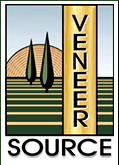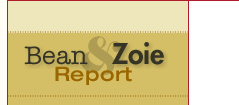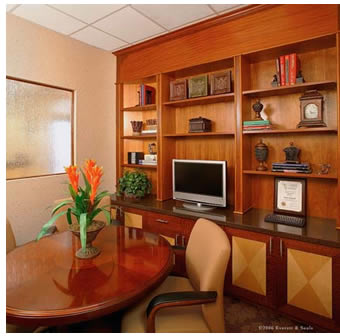







 The manner in which a log segment is cut with relation to the annual rings will determine the appearance of the veneer. When sliced, the individual pieces of veneer, referred to as leaves, are kept in the order in which they are sliced, thus permitting a natural grain progression when assembled as veneer faces. The group of leaves from one slicing is called a flitch and is usually identified by a flitch number and the number of gross square feet of veneer it contains. The faces of the leaves with relation to their position in the log are identified as the tight
The manner in which a log segment is cut with relation to the annual rings will determine the appearance of the veneer. When sliced, the individual pieces of veneer, referred to as leaves, are kept in the order in which they are sliced, thus permitting a natural grain progression when assembled as veneer faces. The group of leaves from one slicing is called a flitch and is usually identified by a flitch number and the number of gross square feet of veneer it contains. The faces of the leaves with relation to their position in the log are identified as the tight
face (toward the outside of the log) and the loose face (toward the inside or heart of the log). During slicing the leaf is stressed on the loose face and compressed on the tight face. When this stress is combined with the natural variation in light refraction caused by the pores of the wood, the result is a difference in the human perception of color and
tone between tight and loose faces. The principal methods of slicing veneers and the general visual characteristics of the grain are:
Plain Slicing (or Flat Slicing)
This is the slicing method most often used to produce veneers for high quality architectural woodworking. Slicing is done parallel to a line through the center of the log. A combination of cathedral and straight grain patterns results, with a natural progression of pattern from leaf to leaf.
Quarter Slicing (or Quarter Cut)
Quarter slicing simulates the quarter sawing process of solid lumber, roughly parallel to a radius line through the log segment. In many species the individual leaves are narrow as a result. A series of stripes is produced, varying in density and thickness from species to species. “Fleck” (sometimes called flake) is a characteristic of this slicing method in Red and White Oak.
Rift Slicing (or Rift Cut)
Rift veneers are produced most often in Red and White Oak, rarely in other species. Note that rift veneers and rift sawn solid lumber are produced so differently that a “match” between rift veneers and rift sawn solid lumber is highly unlikely. In both cases the cutting is done slightly off the radius lines minimizing the “fleck” (sometimes called flake) associated with quarter slicing.
Comb Grain
Limited in availability, comb grain is a select product of the Rift process distinguished by tight, straight grain along the entire length of the veneer. Slight angle in the grain is allowed. Comb grain is restricted to Red and White Oak veneers.
Rotary
The log is center mounted on a lathe and “peeled” along the general path of the growth rings like unwinding a roll of paper, providing a generally bold random appearance. Rotary cut veneers may vary in width and matching at veneer joints is extremely difficult. Almost all softwood veneers are cut this way. Except for a specific design effect, rotary veneers are the least useful in fine architectural woodwork.
Note: Rotary sliced fine hardwood veneers are used in a limited way, and usually for special figure and cut, in the manufacture of Premium Grade woodwork. Careful consideration, specification, and communication are recommended when rotary cut is contemplated.
Composite VeneersSliced from fast-growing trees, these veneers are dyed and then reglued in molds to create “grain” patterns.
The color is established during manufacture because the high percentage of glue lines resist staining by the
woodworker. Must be specified by brand name and manufacturer?fs designation. “Matching” between
components may not be possible.
... that managed forests, thanks to their high proportion of young, strong, growing trees, enable CO2 to be extracted?
... that an old, unmanaged forest produces as much CO2 through processes of decomposition and decay as it stores, and that therefore an unmanaged forest contributes nothing to reducing global CO2?

Phone: 407-423-2252 • Fax: 407-423-1566 • sales@veneersource.com